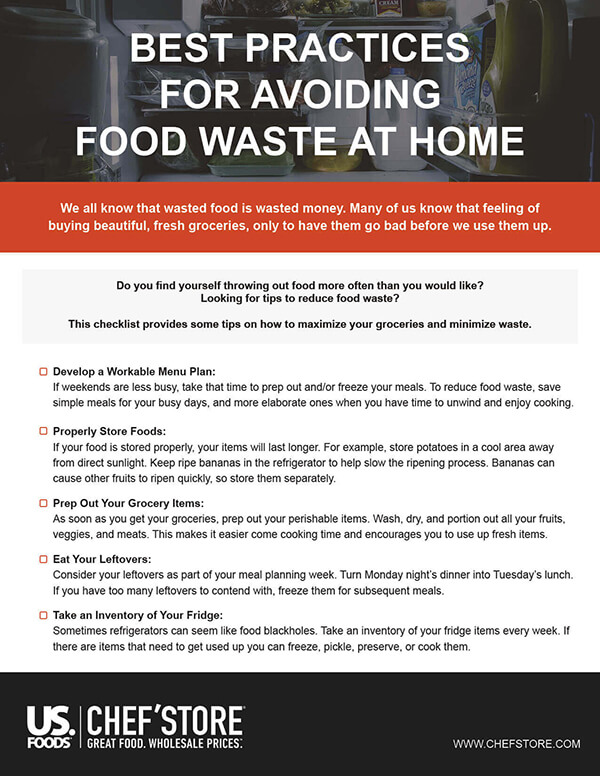May 06, 2020

8 Ways Buying Fresh Fruits & Veggies in Bulk Can Stretch Your Grocery Budget
1. Plan your meals
2. Pickle and ferment vegetables
3. Dehydrate fruits and vegetables
4. Drink your fruits and veggies
5. Save food scraps
6. Freeze fresh herbs
7. Preserve berries
8. Have a family cooking competition
To help stretch grocery budgets, most families turn to pantry items like dried beans, grains, and pastas. While these are great items to keep around, don't neglect those fresh fruits and vegetables. Fresh produce is a healthy addition to any menu and can also be used for juices, marinades, and more!
When you purchase wholesale produce in bulk, not only are you getting high-quality vegetables and fruits, you are maximizing your dollar. This is key since food-at-home prices skyrocketed 8.6% during the past year — their fastest pace since April 1981 — according to Consumer Price Index (CPI) data for February released Thursday by the U.S. Bureau of Labor Statistics (BLS). Concerned about fresh produce spoiling? Don't worry! With a little planning you can prevent food waste and save on grocery costs. Read on for ways to stretch your food budget.
How Can I Eat More Fruits and Vegetables On a Budget?
When shopping for food on a budget, go ahead and fill up your cart with wholesome fruits and veggies from your wholesale grocery store. While you might be worried about spoilage, there are a variety of ways to use up bulk produce and reduce food waste. From meal planning, to pickling, to creative solutions for scraps, these eight tips will help you make the most out of your fresh food!
1. Plan Your Meals
We all have the best intentions for our fresh fruits and veggies. If we don't plan how and when to use them some of that gorgeous produce ends up going to waste. One way to make sure you are getting the most of your produce items is to plan out menus before purchasing your wholesale groceries. Having set menus will help you purchase the right amount of bulk produce for your needs, and will ensure your fruits and veggies are getting used. The best part? You can turn the menu planning into a fun family activity!
Here are a few meal planning ideas to get you started:
- Friday pizza night: Instead of pre-made tomato sauce you can make your own with fresh tomatoes, garlic, and herbs. Get inventive and make cauliflower crust for a healthy, low-carb option.
- Healthy soups: From hearty vegetable stews to old-fashioned chicken noodle, soups are a superb way to use up your veggies. If you want to put an interactive spin on this warming dish, have the family participate in a Stone Soup meal. Each person gets to contribute their favorite veggie to the pot.
- Stir fry: Stir frys are a great way to incorporate a variety of veggies into a meal. Plus they make great leftovers!
2. Pickle and Ferment Vegetables
Pickling and fermenting veggies is a genius way to stretch the longevity of vegetables. Have some cucumbers that are on their last legs? Turn them into refrigerator pickles. You don't have to stop there. Anything from beets, to onions, to fruit can be quick-pickled and stored in your fridge. They make a great addition to salads, cheese boards, and sandwiches.
You can also ferment a variety of vegetables at home. Cabbage-based fermented condiments like sauerkraut and kimchi are easy to make, delicious to eat, and get better with time! Plus they are great probiotics!
3. Dehydrate fruits and vegetables
If you own a food dehydrator, you can turn almost anything into a healthy snack, while reducing food waste. Make your own dried apples and pears to use as a midday crunchy snack or as a gluten free cracker for cheese and dips. For a nutritious alternative to potato chips, make some earthy kale chips. The options are limitless when it comes to dehydrating fruits and veggies. Don't own a food dehydrator? Not to worry. You can dry most foods in your home oven.
4. Drink Your Fruits and Veggies
Stay healthy and use up your produce by making smoothies and fresh juice. Start your morning off with an energy boosting fresh squeezed juice or antioxidant rich smoothie. For smoothies, pre-portion and freeze all of your leafy greens, fruits, and veggies to save time and preserve your produce. Turn your lemons into lemonade or try a seasonal Agua Fresca. For a treat to beat the heat, make your own juice popsicles.
5. Save those Food Scraps
There's no need to toss your carrot tops or onion peels into the compost. Even those small bits of leftover vegetables and herbs can be used to make great meals at home. Here are a few creative ways to use produce scraps:
- Kitchen scrap vegetable stock: Keep a plastic, zippered storage bag in your freezer and fill it with all your vegetable prep scraps, including onions, celery, carrots, herb stems, etc. Once the bag is full, place it in a stockpot of water and simmer on low to thaw.
- Carrot top pesto: Save the leafy tops and turn them into a dynamic pesto. You can even freeze the sauce for later use.
- Marinades and vinaigrettes: Simply blend leftover herbs, veggies, and fruits with some olive oil and vinegar to create delicious salad dressings and meat marinades.
6. Freeze fresh Herbs
If you notice your greens and herbs starting to wilt, pop them in the freezer. Chop up your fresh herbs and freeze them in an ice cube tray with olive oil. Later, pop them in a skillet and use them for sautéing. Trim down your leafy greens, like spinach, kale, chard, etc. and place them in a freezer bag. You can use them for smoothies, soups, breakfast scrambles, or casseroles.
7. Preserve Berries
Berries can go from succulent to spoiled rather quickly. To increase the longevity of fresh berries, turn them into jams, jellies, compotes, and syrups. Berries can be preserved by canning, freezing, or dehydrating. Use the preserved berries as a sweet topping for French toast, a savory element to roasted meats, or an innovative addition to a charcuterie board.
8. Family Cooking Competition
Turn dinner into a fun family activity and use ingredients with an at-home cooking competition. Take a nod from Food Network's Chopped series and create a dish around basket ingredients. It's a perfect activity to introduce kids to cooking and make the most out of leftover ingredients. You can also feature a single ingredient, a la Iron Chef. Encourage the whole family to develop a full meal, from appetizer to dessert, with the secret ingredient.
US FOODS CHEF'STORE, Where Families Purchase Wholesale Produce
At CHEF'STORE we know that high-quality produce at competitive prices is important to our customers. We have all the fresh fruits and vegetables you need to make budget-friendly, home cooked meals. What's more? We deliver via Instacart so you can conveniently shop from the comfort of your own home and still maximize your grocery budget.
